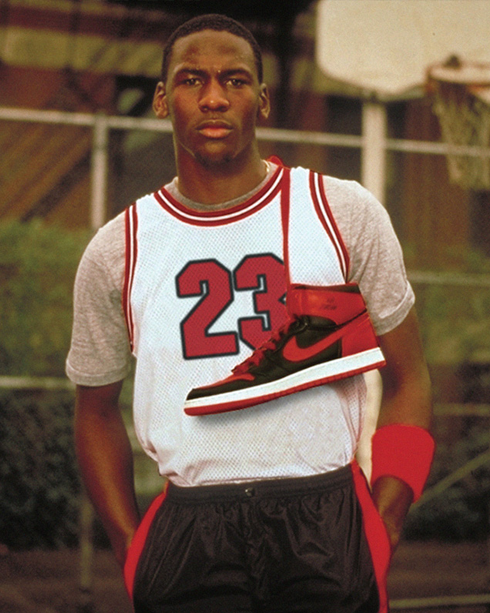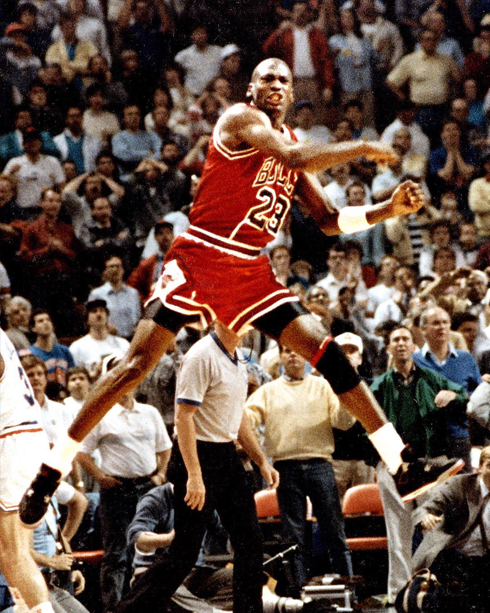Jordan
5
The sneaker modelled on a WWII fighter plane.

A new challenge
By the summer of 1989, Michael Jordan and Tinker Hatfield had already achieved great things, the former establishing himself as one of the best basketball players of all time, the latter one of the greatest shoe designers of his generation. Having delivered a brand-saving basketball trainer in the Air Jordan 3 and another groundbreaking model in the Air Jordan 4, Hatfield had now turned his attention to the line’s fifth iteration and his third Jordan sneaker. Meanwhile, MJ himself was preparing for another season in the NBA after losing to the Detroit Pistons in the last round of the Eastern Conference playoffs and narrowly missing out on the NBA finals. Despite this, it was a great time for the great man as the Chicago Bulls were becoming a team that could seriously challenge for the championship thanks to the newly appointed head coach, Phil Jackson, and Jordan’s ever-improving partnership with Scottie Pippen. This left Tinker with a challenge: to produce another iconic basketball shoe that would both support the player, driving him forwards to bigger and better things, and please the many adoring fans of his previous two Jordan designs. The ambitious architect-turned-shoemaker didn’t disappoint, creating the Air Jordan 5: a pioneering sneaker with trailblazing features and a dynamic aesthetic that simply could not be ignored.
The fabulous Michael Jordan
Having worked closely with Michael on Jordans 3 and 4, Tinker did the same for the Jordan 5, watching the player on the court to get a feel for both his style and his mindset. He found that Jordan was a tenacious attacker with a fierce desire to win and an intelligence to match. The man’s ruthless streak also became apparent to him as Jordan would often react to being targeted or slighted by raising his game to even higher levels, sometimes humiliating his opponents in the process. As he continued to watch Jordan play, he realised that what he was watching was akin to a fighter plane from WWII: fast, agile, attacking from all directions and entirely unforgiving of his opponents. Inspired, he went away to consider how best to represent this on his new sneaker.
An unexpected inspiration
From Tinker’s sketches, it’s clear to see how important this representation was on the Jordan 5, as well as how much hard work and effort went into creating it. An early drawing from January 1989 shows the sneaker in a nascent state, with elements that didn’t make the final design, such as the rubber lace cover, along with those that did, including the flex grooves in the outsole. One feature that really stands out, though, is the set of razor-edged shark teeth zig-zagging along the midsole. This dynamic effect certainly did make the finished version of the AJ5 and remains one of its most distinctive features over three decades later. Its origins lie in the WWII fighter plane that Tinker imagined as he experienced Jordan’s dominance on the court – the P-51 Mustang. Like many aircraft before it, the Mustang was often decorated with nose art that replicated the fearsome mouth of a shark, its sharp teeth providing a menacing look that intimidated the enemy and displayed strength and aggression, all while empowering the pilot. This predatory sneer is something Jordan himself showed during matches when he was agitated and felt like dismantling the opposition. When he got this look, he could strike fear into his opponents in just the same way, so Tinker made a shoe that would have a similar effect. Interestingly, following many conversations he and Michael had had about “zigging while everybody else was zagging”, he decided to have the teeth pointing forwards even though a shark’s teeth normally point backwards as a way of subverting people’s expectations. Thus, the characteristic shark teeth of the Air Jordan 5 were born.
An unconventional outsole
While the shark teeth gave the midsole of the Air Jordan 5 its distinctive aesthetic, there were many other design features that forged its unique look and others that made it an excellent piece of performance footwear, achieving that classic Tinker balance of technological brilliance and lifestyle wearability. It had a partially translucent outsole inspired by the designer’s recent work on the Nike Mag for the movie Back to the Future II, in which main character Marty McFly donned a pair of the futuristic boots. Tinker had been enamoured by the way the Mag’s outsole had allowed light to shine through it and aimed to replicate this effect on the Jordan 5. He contrasted translucent and opaque rubber and placed a large Jumpman logo behind the forefoot as if to emphasise its see-through nature.
A new tongue design for the Air Jordan line
As well as being the first basketball trainer to have this type of outsole, the AJ5 had another feature that had never been used on a shoe of this kind before. It formed part of the tongue, which was an area Tinker was keen to rework, as is evident from a drawing of his dated 10th May, 1989. Labelled “New Tongue Design for Air Jordan”, it presents an updated design with mesh at both ends. While the lower tongue on the finished sneaker was covered in a latticework mesh that matched the panels set into each sidewall, its upper half had undergone a radical change. Rather than the “clear PVC mesh” depicted in the sketch, it ended up coated in a reflective silver material which was used on the running shoes of the day to make them visible at night, but had never been implemented on a basketball model before. This was another smart move by Tinker, who wanted the tongue to shine brightly when photographed. Every time Michael made an appearance in the Air Jordan 5, the reflective tongue would draw attention by lighting up as the audience took photos of it, each camera flash highlighting the striking Jumpman logo in its centre, and thus the brand as well.
A shoe of firsts
The novel elements of the Air Jordan 5 did not end there either. It was also equipped with a new lace lock system consisting of a toggle surrounded by a plastic housing. This helped to keep the laces securely tied at all times, giving the wearer confidence on the court. Moulded foam pads then came bulging out around the collar to provide extra protection over the ankles. These bold protrusions formed part of a new-look collar whose asymmetric construction saw the medial side reach higher than the lateral one in a more ergonomic design that better matched the curvature of the ankles. More familiar features like visible Air cushioning in the midsole and a Nike Air logo on the heel hinted at the model’s strong pedigree, while the new design of its overlays, particularly the eccentric shape of the heel counter and the moulded TPU eyelets, made it aesthetically distinct from its popular predecessors.
Four debut colourways
By the time of its release in early 1990, it was clear that Tinker Hatfield had produced another icon of the sporting world. Despite the huge success of the Air Jordans 3 and 4, he had managed to innovate yet again, designing a shoe packed with new features that performed on the court and looked great off it. Hatfield delivered four colourways in its debut year, each with either black or white as the main colour and more vibrant tonal accents on areas like the sole unit, branding and inner. There was the Black Metallic, whose black nubuck upper was underpinned by a similarly coloured midsole with silvery grey shark teeth covered in black speckles. Then there were the two Fire Red colourways, both of which had an elegant white upper, with one displaying a silver reflective tongue, a black midsole and red shark teeth, the other a black tongue and shark teeth upon a red midsole. Despite not having a reflective tongue, this second Fire Red design had a unique aesthetic touch on its lateral heel in the form of Jordan’s jersey number of 23 in vivid red embroidery with a black edge that lifted it visually from the surface. This was the only one of the four general release Jordan 5s to have this feature, though Michael’s Player Exclusive Black Metallics also had a 23 on them. The fourth and final colourway, nicknamed Grape, went in a different direction, employing purple and turquoise hues on its tongue and midsole in line with the fashion trends of the new decade.
A symbiotic relationship
The Air Jordan 5 came out during a time when Michael Jordan and the Chicago Bulls were approaching their prime as a combined unit. Although individually he had already accomplished great things, the ‘89-’90 season was one where he began to add new aspects to his game that would make him a better team player and help bring the Bulls a string of titles throughout the 1990s. As with previous iterations of his signature sneaker, Michael formed a somewhat symbiotic relationship with it as each elevated the other to greater and greater heights. The shoe’s performance features supported the player to his fourth consecutive season as Scoring Champion and saw him grow his ever-expanding skillset to include three-pointers, of which he made 92 – a vast improvement on the 68 he had scored in the previous five seasons combined, and something that encouraged him to compete in the All-Star Event’s 3-Point Contest for the only time in his career. It also allowed him to maintain and enhance his defensive skills as he became Steals Leader for the second time and made the All-NBA First Team and the NBA All-Defensive First Team once again. In return, his headline-grabbing exploits drew attention to the Jordan 5, endearing it to the massive fanbase of the Jordan sneaker line and ensuring that it would be another huge success.
A career milestone
One particularly memorable game that demonstrated the wonderful symbiosis of Michael and the Jordan 5 came on 28th March, 1990, when the Chicago Bulls faced the Cleveland Cavaliers. The match was held in the Cavs’ Coliseum at Richfield stadium, so the crowd were fervently behind their home team and the environment was hostile to Jordan and the Bulls. Far from helping the Cavaliers to victory though, this was what led to their eventual downfall. As many teams did at that time, the Cavs went hard at Jordan, trying to rough him up and upset his game. When the towering 6’11” ‘Hot Rod’ Williams fouled Chicago’s star player and clearly hurt him, the Cavaliers fans cheered. However, far from intimidating him, this act angered Jordan, who was renowned for rising to any challenge. After the game, he revealed that this was the moment he “went crazy”, bringing his power, determination and fearlessness to bear in an awe-inspiring display that powered his team to victory. Showing the kind of ruthlessness and aerial threat that had inspired Tinker’s fighter plane analogy, he attacked from all angles, outmanoeuvring and outpacing his opponents to leave them “shell-shocked”, as one commentator described the Cavs at the end of the game. By this point, he had racked up an incredible 69 points in the overtime win – the highest score by a single player in the NBA for over a decade at the time. It remains the highest scoring game of MJ’s career and still stands as a franchise record to this day. His performance was so physically and mentally dominant that he significantly outperformed the rest of his team, who struggled on the night, ultimately dragging them to victory by sheer force of will. The next closest scorer on his team was Horace Grant with 16 points, and no one else made double figures. On top of that, he more than doubled the nearest rebound tally, making 18 to Scottie Pippen’s 8. He did all of this while wearing the Air Jordan 5 Fire Red and, though it wasn’t the first time he’d been seen in the shoe – that honour went to the All-Star Weekend of February 1990 – it brought the new model masses of hype and attention.
The Fresh Prince and the Grape colourway
Jordan’s on-court magic was not the only thing to make the Air Jordan 5 so popular though; it was also helped by its pop culture appearances. Mars Blackmon renewed the partnership he had formed with Michael years earlier on the AJ3 by appearing in a series of quirky commercials to coincide with the launch of the Jordan 5. Spike Lee’s eccentric Jordan enthusiast showed up in TV and print ads, uttering well-known phrases like “Is it the shoes?”, which had been used before as a subtle suggestion that it was possible to emulate some of Michael’s greatness by wearing his basketball trainers. Later that year, another unforgettable TV personality of the era donned the Air Jordan 5 in the Fresh Prince of Bel Air. Broadcast for the first time in September of 1990, which was incidentally when Jordan started his first title-winning season, the series focused on the happy-go-lucky Will Smith. During the show, he often wore bold, brightly coloured clothing, representing, and in some ways setting, the style of the early 90s, so the fluorescent turquoise and purple accents on the Grape colourway made it the perfect sneaker for him to wear. Throughout the program’s six-year span, he appeared in many different Jordans, including the Black Metallic and Fire Red AJ5s, but the Grape was one of his most regular picks. His contribution to its success was so significant that Jordan Brand honoured him with the Air Jordan 5 Bel Air in 2013 before creating two special editions to celebrate his 50th birthday in September 2018. One of these Fresh Prince colourways was modelled on the unique way Will Smith would wear his Grapes on the show – without any laces at all – while the other was a unique Friends and Family design with a gleaming golden upper.
Continued success
Despite the initial success of the Air Jordan 5, it was not recreated as a retro edition until ten years after its release. When it was re-launched in 2000 as the first Jordan retro of the new millennium, the shoe was as popular as ever, leading to the creation of more colourways in the years that followed. The collection continues to expand to this day, with re-releases of classic designs coming out alongside brand new colourways almost every year. It has also been used as the template for a number of stylish collaborations, where it has continued the Jordan 5’s tendency to achieve Jordan Brand firsts. It was used for Supreme’s debut Jordan sneaker and was chosen as the silhouette for a partnership with Paris Saint-Germain: the first time the brand had worked with a sports team outside of the United States. Flamboyant Brazilian footballer Neymar has his own captivating low-top, and renowned American record producer DJ Khaled has been involved in designing several AJ5s. Beyond this, stunning Jordan 5s have been created together with sneaker boutiques like Marcus Jordan’s Trophy Room and luxury fashion brands such as Virgil Abloh’s Off-White™ and A Ma Maniére.
A shoe for the ages
After crafting two classic sneakers in the Jordan 3 and 4, Tinker Hatfield could have been forgiven for producing something less than spectacular for the Air Jordan 5. Rather than simply churning out the next iteration in the signature line, though, he proved his exceptional design credentials by forging a shoe for the ages. Its characteristic shark teeth and powerful aesthetic embodied Jordan’s fearless mindset and bold style of play like nothing before it. When added to its translucent outsole and reflective tongue, this gave the AJ5 a completely unique look on its release, while the use of Nike Air and mesh panelling ensured that it was as bouncy as it was breathable, allowing Jordan and other players to feel comfortable and agile on the court. Since then, it has continued to influence sneaker culture, many of its features being regularly incorporated into more recent designs, both Jordan and otherwise. Michael’s career-defining 69-point game, alongside his many other great performances from that season, established the Jordan 5 as an excellent basketball trainer, while Will Smith’s vibrant style in the Fresh Prince gave it credence as a lifestyle model, ultimately making it an icon of sneaker history.

